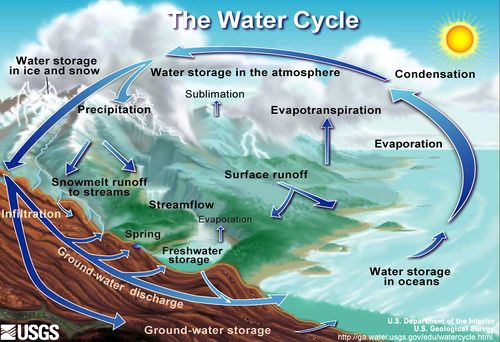Precipitation
Rainfall occurs due to precipitation.
In meteorology, precipitation is any product of the condensation of atmospheric water vapor that falls under gravity. The main forms of precipitation include drizzle, rain, sleet, snow, graupel and hail. Precipitation occurs when a portion of the atmosphere becomes saturated with water vapor, so that the water condenses and "precipitates". Thus, fog and mist are not precipitation but suspensions, because the water vapor does not condense sufficiently to precipitate. Two processes, possibly acting together, can lead to air becoming saturated: cooling the air or adding water vapor to the air. Precipitation forms as smaller droplets coalesce via collision with other rain drops or ice crystals within a cloud. Short, intense periods of rain in scattered locations are called "showers." [1]
Precipitation is any type of water that forms in the Earth's atmosphere and then drops onto the surface of the Earth.
Water vapor, droplets of water suspended in the air, builds up in the Earth's atmosphere. Water vapor in the atmosphere is visible as clouds and fog. Water vapor collects with other materials, such as dust, in clouds.
Precipitation condenses, or forms, around these tiny pieces of material, called cloud condensation nuclei (CCN).
Clouds eventually get too full of water vapor, and the precipitation turns into a liquid (rain) or a solid (snow).
Precipitation is part of the water cycle. Precipitation falls to the ground as snow and rain. It eventually evaporates and rises back into the atmosphere as a gas. In clouds, it turns back into liquid or solid water, and it falls to Earth again. People rely on precipitation for fresh water to drink, bathe, and irrigate crops for food.
The most common types of precipitation are rain, hail, and snow. [2]
